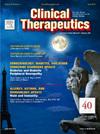Pegylated Liposomal Doxorubicin Confers a High Risk for Pneumocystis Jirovecii Pneumonia in Patients With Diffuse Large B-Cell Lymphoma
IF 3.6
4区 医学
Q2 PHARMACOLOGY & PHARMACY
引用次数: 0
Abstract
Purpose
Pegylated liposomal doxorubicin (PLD) has emerged as an effective therapeutic option for diffuse large B-cell lymphoma (DLBCL). While demonstrating an improved safety profile compared to conventional doxorubicin, PLD has been associated with a potentially elevated risk of Pneumocystis jirovecii pneumonia (PJP), warranting clinical vigilance. This study aimed to evaluate the association between PLD administtion and PJP development in patients with diffuse large B-cell lymphoma (DLBCL).
Methods
We conducted a comparative analysis of 43 chemotherapy-treated DLBCL patients with PJP versus 195 contemporaneous DLBCL controls without PJP. The evaluation included PLD administration patterns and covariate-adjusted risk assessments.
Fingdings
The analysis revealed significant differences between PJP cases and controls. Patients who developed PJP were more likely to have received PLD-containing chemotherapy regimens (p = 0.001) and less likely to have received TMP-SMX prophylaxis (p = 0.001). The majority of PJP cases (51.2%) occurred after 3-4 chemotherapy cycles, with an 18.6% case-fatality rate (n = 8). Multivariable logistic regression identified 2 independent predictors, PLD-containing regimen (OR: 3.2, 95% CI: 1.5–6.8; P = 0.003) as a risk factor; TMP-SMX prophylaxis (OR: 0.4, 95% CI: 0.2–0.8; P = 0.003) as a protective factor. Notably, baseline characteristics including demographic parameters, disease stage, ECOG performance status, LDH levels, and IPI scores showed no significant intergroup differences (all P > 0.05).
Implications
These findings demonstrate a clinically significant association between PLD-containing regimens and PJP development in DLBCL patients. Regular clinical and radiographic monitoring for PJP symptoms should be implemented and PJP prophylaxis should be strongly considered for all patients receiving PLD-based therapy.
多柔比星聚乙二醇脂质体对弥漫性大b细胞淋巴瘤患者的耶氏肺囊虫肺炎具有高风险。
目的:聚乙二醇化脂质体多柔比星(PLD)已成为弥漫性大b细胞淋巴瘤(DLBCL)的有效治疗选择。虽然与传统的阿霉素相比,PLD的安全性得到了改善,但PLD与乙基肺囊虫肺炎(PJP)的潜在风险升高有关,需要临床警惕。本研究旨在评估弥漫大b细胞淋巴瘤(DLBCL)患者PLD给药与PJP发展之间的关系。方法:我们对43例化疗后合并PJP的DLBCL患者与195例同期无PJP的DLBCL对照进行了比较分析。评估包括PLD给药模式和协变量调整风险评估。结果:分析显示PJP病例和对照组之间存在显著差异。发生PJP的患者更有可能接受含pld的化疗方案(p = 0.001),而较少接受TMP-SMX预防治疗(p = 0.001)。大多数PJP病例(51.2%)发生在3-4个化疗周期后,病死率为18.6% (n = 8)。多变量logistic回归确定了2个独立预测因子,含pld方案(OR: 3.2, 95% CI: 1.5-6.8;P = 0.003)为危险因素;预防TMP-SMX (OR: 0.4, 95% CI: 0.2-0.8;P = 0.003)为保护因素。值得注意的是,包括人口统计学参数、疾病分期、ECOG表现状态、LDH水平和IPI评分在内的基线特征在组间无显著差异(均P < 0.05)。意义:这些发现表明含pld方案与DLBCL患者PJP发展之间具有临床意义的关联。应实施PJP症状的定期临床和放射学监测,并应强烈考虑对所有接受pld治疗的患者进行PJP预防。
本文章由计算机程序翻译,如有差异,请以英文原文为准。
求助全文
约1分钟内获得全文
求助全文
来源期刊

Clinical therapeutics
医学-药学
CiteScore
6.00
自引率
3.10%
发文量
154
审稿时长
9 weeks
期刊介绍:
Clinical Therapeutics provides peer-reviewed, rapid publication of recent developments in drug and other therapies as well as in diagnostics, pharmacoeconomics, health policy, treatment outcomes, and innovations in drug and biologics research. In addition Clinical Therapeutics features updates on specific topics collated by expert Topic Editors. Clinical Therapeutics is read by a large international audience of scientists and clinicians in a variety of research, academic, and clinical practice settings. Articles are indexed by all major biomedical abstracting databases.
 求助内容:
求助内容: 应助结果提醒方式:
应助结果提醒方式:


